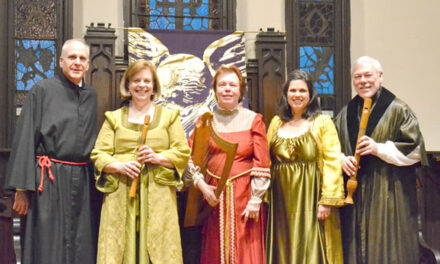Guest conductor Jorge Mester chose a challenging and innovative program for the all-student Eastern Music Festival’s Young Artists Orchestra. During his 12-year tenure (1967-1979) as music director of the Louisville Orchestra (Kentucky), Mester made 72 world premiere recordings with the orchestra. This series, along with EMF music director Gerard Schwarz’s series for Delos (Naxos reissues), was the most significant contribution to contemporary music since the eras of Serge Koussevitsky and Leonard Bernstein.
“Bells for Stokowski,” the finale of the three movement Philadelphia Stories by Michael Daugherty (b. 1954), was a smorgasbord of allusions to the famous innovative conductor and of instrumental technique for nearly 100 young players on the stage of Dana Auditorium. “Stereo effects” from the spatial placement of extra instruments was a significant feature of the work. A pair of harps faced each other, squeezed forward between the two violin sections and the viola and cello sections respectively. Similarly, pairs of percussionists were located at opposite ends of the rear stage. The program notes quote the composer “I utilize multiple musical canons, polyrhythms, and counterpoints to achieve a complex timbral layering throughout . . .”
The work opened with the evocative suggestion of distant bells. In the first of several prominent violin solos, Concertmistress Holly Jenkins used multiple bowings, ranging from playing close to the bridge to applying a schmaltzy vibrato, to convey Daugherty’s Bach-like original theme. Great washes of sound were followed by a gorgeous viola solo played by Emma Dansak, accompanied by the sounds of plucked strings from harpist Caroline Nelson and resonant double-bass pizzicatos. Another episode of unexpected orchestral swoops, rowdy brass and percussion was followed by a lovely cello played by Hsaio-Hsuan Huang set against mellow support from harpist Nelson and the woodwinds. Jenkins’ violin solo was like a high wire act, played precisely and shrilly in the violin’s highest register. Another orchestral collage of sound was followed by a striking, high-pitched cello solo from Huang, supported by harpist Michael Maganuco and the woodwinds. Brass and percussion dominated the tsunami-like forte conclusion. Daugherty’s kaleidoscopic orchestration invites repeated listening.
The Clarinet Concerto in A minor, K.622 of Wolfgang Amadeus Mozart (1756-1791) received a magnificent interpretation from guest soloist Jon Manasse, expertly supported by Mester and his alert and enthusiastic young musicians. Mozart scored this concerto for a so-called “basset-clarinet” which had “four additional semitones below the bottom note of the soprano clarinet in A,” according to Steven Ledbetter’s informative notes. This lost original score has been reconstructed but the work is most often heard played on the standard clarinet as it was on this occasion. The deft orchestration deliberately helps to emphasize the flowing, sweet tone of the clarinet, a quality Manasse is able to conjure to an extraordinary degree. It was entrancing to mentally glide along as he spun a seamless, seemingly endless stream of mellow melody in the first movement. But this was nothing compared to the unearthly magic of the adagio, “a marking Mozart reserve(d) for his most deeply felt music.” I didn’t think Manasse’s quiet, simple phrasing could be improved upon until his even more hushed reprise which seemed like eavesdropping upon a dream of paradise.
I love works that exploit variations upon a theme and none more than the famed Enigma Variations, Op. 36 of Sir Edward Elgar (1857-1934). When the work was premiered by Hans Richter in 1899, the identities of the fourteen friends of the composers portrayed by the variations were unknown. They have long since been identified but a major mystery remains. The composer’s original program note suggested a further riddle, “a dark saying” that “must be left unguessed.” He clearly states “through and over the whole set another theme ‘goes’ but is not played.” Among a myriad of suggested solutions are Auld Lang Syne, the subtheme of the slow movement of Mozart’s Symphony No. 38, “Prague”(N. Y. Times, 11/7/91), and B-A-C-H. This musical notation corresponds to the notes B-flat, A, C, and B natural in German, according to the late Kenneth Hunt of Australia.
Mester led the orchestra through a hearty, vivid performance of the Enigma Variations in which a number of principal players were able to shine in “mini-portraits” in sound of Elgar’s intimates. The charming clarinet solo in the fifth variation was played by Elizabeth Ramirez, capturing the witty badinage of its subject Richard Penrose Arnold, a son of the novelist Matthew Arnold. The sixth variation, Ysobel, portrays Isabel Fitton, an amateur violist and pupil of the composer. The wonderfully refined viola solo with its deliberately tricky string crossing at the beginning was delivered by Emma Dansak with professional aplomb. The whole ensemble met the challenges of variation IX, Nimrod, magnificently with full, rich playing. The gorgeous cello solo in variation XII, a portrait of amateur cellist Basil G. Nevinson, was phrased with restraint and taste by Hsaio-Hsuan Huang. Everyone richly deserved the enthusiastic multiple curtain calls and Mester’s honoring the many fine section soloists.











